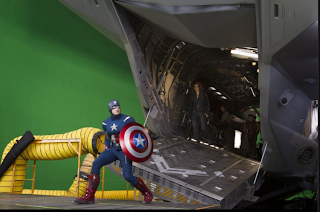I have made my bedroom in to a Camera Obscura! Although not
a pinhole, it is still lens-less technique.
Translated from Latin; camera for 'room' and obscura for 'dark' - together 'darkened room.
Originally used by artists from around 15th/16th century (according to a documentary 'Secret Knowledge' by artist David Hockney, and existing as a visual tool long before) they were used to project a scene on to a canvas or wall which could then be traced and painted over. A camera obscura is made by having a darkened room or box with a hole in one side. The hole should be round with a hard edge for clarity, but any hole will do. Once the hole is small enough, an image should begin to form on the opposite wall and possibly ceilings and floors depending on the size of the room.
Light travels in straight lines, and so images appear upside down on the wall but still in perspective. It is possible to turn the image around using mirrors, and this is how an optical viewfinder works on today's cameras.
Here is a photo of one in action:
Translated from Latin; camera for 'room' and obscura for 'dark' - together 'darkened room.
Originally used by artists from around 15th/16th century (according to a documentary 'Secret Knowledge' by artist David Hockney, and existing as a visual tool long before) they were used to project a scene on to a canvas or wall which could then be traced and painted over. A camera obscura is made by having a darkened room or box with a hole in one side. The hole should be round with a hard edge for clarity, but any hole will do. Once the hole is small enough, an image should begin to form on the opposite wall and possibly ceilings and floors depending on the size of the room.
Light travels in straight lines, and so images appear upside down on the wall but still in perspective. It is possible to turn the image around using mirrors, and this is how an optical viewfinder works on today's cameras.
Here is a photo of one in action:
And here is one created using a mirror to rotate the image:
After covering the windows in foil I then cut a hole approx. 3in by 3in to let light in. This projected the view outside on to my walls and ceiling as I had hoped but it was a little fuzzy, and the view is not nearly as spectacular as the ones above. I was happy with my experiment, but I wanted to take it further and actually take a photograph using my room, with no 'camera' involved.
To do this I did need a lens, as I couldn’t achieve the correct sharpness on the paper without it. (I did experiment with smaller apertures, but by the time it was in focus it was extremely hard to compose as it was so dark).
I placed a magnifying lens in front of the hole, cut a 2cm diameter circular aperture out of black card, and made a makeshift holder out of strong cardboard to hold the aperture, lens and shutter. The image was in focus at 34 cm making my aperture f/17 (nearest typical equivalent being f/16).
To find this out I used a piece of white paper, which I moved back and forth in front of the aperture until the image was in focus, then measured this distance. I took a light reading and my shutter speed was to be 1 second. I was using a black card slider to close the shutter, and this worked fine in practice, but it turned out that sliding it back in when the room was dark was harder than I had thought!
I am yet to develop these images but I will find out soon whether or not I have ruined them or not, fingers crossed its all O.K.!
Happily they did turn out:
Not straight, and not sharp enough, I will have another go with this shot. The problem was that I lined up the image on the front of the box, and the paper was stuck to the back of the box, this meant the paper was about 1 inch further away from the focal point meaning it lost sharpness. The image isn't straight because I stuck it to the box with one piece of blue tack in the middle, in the dark, and so the paper slipped when I turned the box upright.
Here is the second image:
Yep, in the negative those are my fingers! I couldn't get my improvised shutter back in and so I grabbed the box and flung it on to my bed. This has cause a double exposure effect where you can see each window frame and other features appear twice. The other 'whooshy' marks are from the developing process. I dragged the photo out of the developer as it was developing quickly - within 15 seconds (usually takes a whole minute) - and I didn't want to lose it. I think this has left a pretty cool effect and I like the overall look, I will hopefully explore this further. I have removed my fingers in the positive using Photoshop as they were distracting and not meant to be there.
This is all still in the experimental stage and so I am very happy with the results.
I will upload images of what my room actually looks like when I get round to taking photographs of it.
Here is a projected image on some plain printing paper at f/18 you could pick out individual bricks on the walls of the houses and individual trees in the back ground.
This is how I had to improvise to hold my paper high enough for the hole, a set of boxes on top of a ironing board!
to go to the next post click here











































